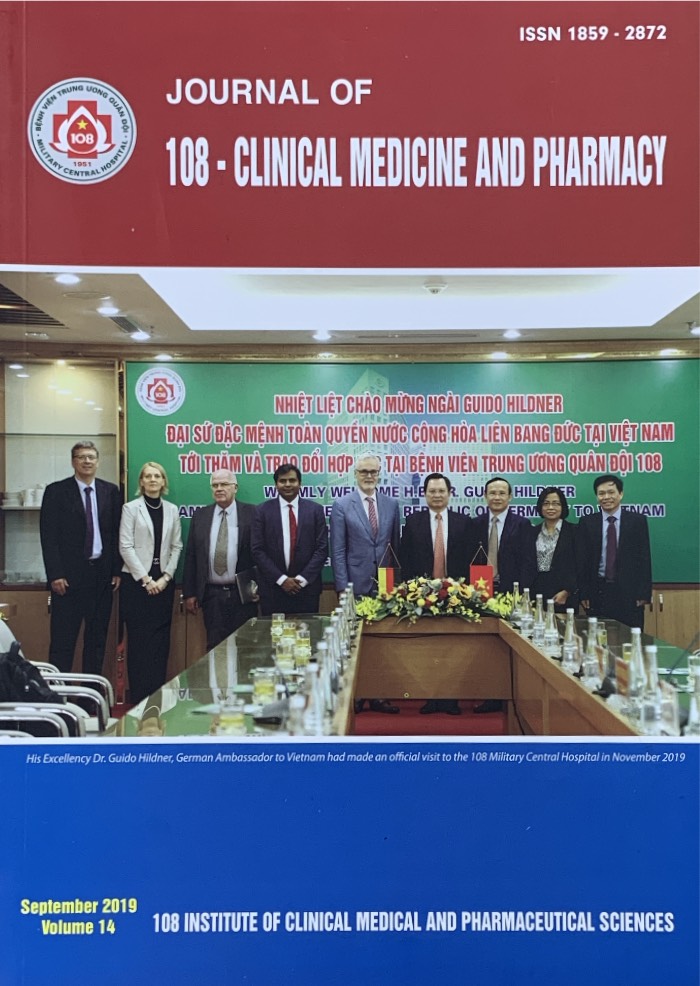The evaluation of magnetic resonance arthrography characteristics in finding shoulder joint injury lesions
Main Article Content
Tóm tắt
Objective: Evaluation of some characteristics of shoulder joint injury lesions by 3.0 Tesla magnetic resonance arthrography (MRA). Subject and method: 39 patients with shoulder joint injuries underwent MRA 3.0 Tesla, cross-sectional descriptive study from February 2012 to August 2017. Result: There were 29 of patients who had rotator cuff lesions, 74.4% respectively. In which, there were 38.5% of patients who had a partial rotator cuff tear, supraspinatus partial thickness tear was the most common with 80.0%. The most common lesion in stage 3 with partial tear classification by Ellman and Habermeyer were 60.0% and 66.7% respectively, the difference between the classified by its is statistically significant with p<0.05 and kappa 0.86. The percent of patients with partial thickness bursal-side tear was the highest 53.3%, articular-side tear was 33.3%, interstitial tear was 13.3%, the difference between the classified by its is statistically significant with p<0.05. There were 25.6% of patients who had a complete tear of rotator cuffs tendon, supraspinatus full thickness tear was the most common with 70.0%, retraction in stage I, which is the lowest in classification by Patte and Baterman both were 20.0%, (kappa = 1.0). Supraspinatus tendon edema were the most common with 71.8%. The labrum lesion with type IV was the most common with 71.4%, type I, II, III were 3.6%, 7.1%, 17.9% respectively. Soft Bankart was the most common with 57.1%, osseus Bankart 28.6%, various Bankart 14.3%. Anatomical labrum varies was 12.8%. Hill-Sachs lesions 25.6%. SLAP lesions were 53.8%, in which, type II was the most common with 57.1%. Inferior glenohumeral ligament lesion was the most common with 45.0%, the difference between the number lesions of glenohumeral ligaments was statistically significant with p<0.05. Humeral head lesions were 71.8%, in which, osseus edema 100%. Conclusion: MRA was useful tools to gives a full and detailed assessment of the level and forms image lesions finding of shoulder join injuries.
Article Details
Các tài liệu tham khảo
2. Pham Hong Ha (2009) Research and application of laparoscopic surgery to treat anterior shoulder joint dislocation recurrence according to Bankart technique. PhD thesis of Medicine, Orthopedic Trauma, Clinical Medical and Pharmaceutical Research Institute Scientific 108, Hanoi: 01-142.
3. Phan Chau Ha et al (2006) Study on application of shoulder-joint magnetic resonance arthrography technique. National Vietnam Society of Rodiology and Nuclear Medicine Conference: 41-47.
4. Chun KA et al (2010) Comparisons of the various partial-thickness rotator cuff tears on MR arthrography and arthroscopic correlation. Korean J Radiol 11(5): 528-35.
5. Davies AM (2006) Imaging of the shoulder: Techniques and applications. Diagnostic Imaging, Springer: 03-78.
6. Kashani ES et al (2008) Is the Bristow- Latarjet operation effective for every recurrent anterior shoulder dislocation. Iranian Med 11(3): 270- 273.
7. Sharma G et al (2017) MR imaging of rotator cuff tears: Correlation with arthroscopy. J Clin Diagn Res 11(5): 24-27.
8. Roy JS et al (2015) Diagnostic accuracy of ultrasonography, MRI and MR arthrography in the characterisation of rotator cuff disorders: A systematic review and meta-analysis. Br J Sports Med 49(20): 1316-1328.
9. Zacchilli MA et al (2010) Epidemiology of shoulder dislocations presenting to emergency departments in the United States. J Bone Joint Surg Am 92(3): 542-549.
10. Zlatkin MB et al (2003) MRI of the shoulder, 2nd Edition. Rotator cuff diseases, 6, Lippincott Williams & Wilkins: 118-178
 ISSN: 1859 - 2872
ISSN: 1859 - 2872
